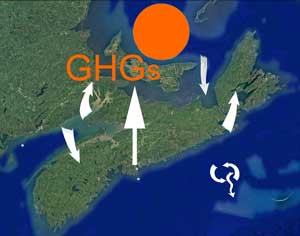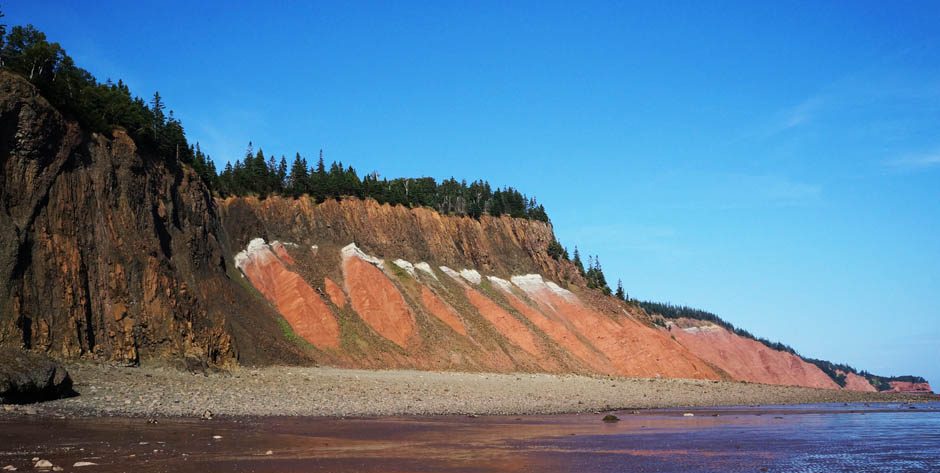 For a few days, warnings of why we need to act quickly to reduce GHG emissions hold the headlines following the latest report from the UN Intergovernmental Panel on Climate Change (IPCC) on Oct 8, 2018:
For a few days, warnings of why we need to act quickly to reduce GHG emissions hold the headlines following the latest report from the UN Intergovernmental Panel on Climate Change (IPCC) on Oct 8, 2018:
Global Warming of 1.5 °C
“An IPCC special report on the impacts of global warming of 1.5 °C above pre-industrial levels and related global greenhouse gas emission pathways, in the context of strengthening the global response to the threat of climate change, sustainable development, and efforts to eradicate poverty” Also available as separate documents: Headline Statements | Summary for Policymakers | FAQs | Press Release
Following are a few highlights from a Washington Post article about the report – The world has just over a decade to get climate change under control, U.N. scientists say by Chris Mooney and Brady Dennis (Oct 7, 2018):
There is no documented historic precedent” for the scale of changes required, the body found….the report clearly documents that a warming of 1.5 degrees Celsius would be very damaging and that 2 degrees — which used to be considered a reasonable goal — could approach intolerable in parts of the world…Specifically, the document finds that instabilities in Antarctica and Greenland, which could usher in sea-level rise measured in feet rather than inches, “could be triggered around 1.5°C to 2°C of global warming.” Moreover, the total loss of tropical coral reefs is at stake because 70 to 90 percent are expected to vanish at 1.5 degrees Celsius, the report finds. At 2 degrees, that number grows to more than 99 percent.
The report found that holding warming to 1.5 degrees Celsius could save an Alaska-size area of the Arctic from permafrost thaw, muting a feedback loop that could lead to still more global emissions. The occurrence of entirely ice-free summers in the Arctic Ocean goes from one per century to one per decade between 1.5 and 2 degrees, it found — one of many ways in which the mere half a degree has large real-world consequences.
Risks of extreme heat and weather events just rise and rise as temperatures do, meaning these would be worse worldwide the more it warms.
To avoid that, in barely more than 10 years, the world’s percentage of electricity from renewables such as solar and wind power would have to jump from the current 24 percent to something more like 50 or 60 percent. Coal and gas plants that remain in operation would need to be equipped with technologies, collectively called carbon capture and storage (CCS), that prevent them from emitting carbon dioxide into the air and instead funnel it to be buried underground. By 2050, most coal plants would shut down.
The IPCC report is also pretty clear that to reduce CO2 emissions over a meaningful timeframe, forest bioenergy systems need to be coupled to Carbon Capture and Storage. Forest bioenergy systems that do not provide net reductions in GHGs compared to alternative fossil fuels within 25 years are contributing to global warming and perhaps more ominously, the danger of run-away warming (e.g. associated with release of carbon dioxide and methane from melting permafrost).
The forest industry can say that we need to look at carbon neutrality over longer time intervals than 25 years, but what if we exceed a threshold on permafrost melting in 25 years (or even less)? That’s part of the worry of the IPCC. These are serious concerns, not posturing or fear-mongering.
I think there is not much issue with localized, small scale use of genuine wastes and thinnings to produce heat as proposed by North Nova Forest Owners Co-op limited/Conform Limited/Alhol Forestry Coop Limited (view post, Sep 27, 2018). It won’t make much contribution towards what is needed, but it will do little harm and could help make forest management that maintains high standing volumes (and hence levels of carbon storage) more feasible.
However, larger biomass projects for generation of electricity, most notably the Port Hawkesbury biomass plant, are clearly harmful both on the clearcutting side* and on the biomass burning side.
_________________
* Observations in NS have shown that clearcutting stimulates loss of up to 50% of soil carbon, with up to 100 years (without clearcutting) required for it to rebound. View also Protected Areas in Nova Scotia help to mitigate climate change, clearcuts do not (Post, May 26, 2017)
It’s time for Nova Scotia to be objective about this issue. Perhaps a field trip to Five Islands Provincial Park would help.

I had climate warming in mind when I used this image as a header for this website a few weeks back. The Exposure at Five Islands Provincial Park records the 4th Mass Extinction (whitish layer), which was associated with environmental impacts of a massive lava flow, recorded in the basalts above it; a skin of today’s forest lies on top (the intervening softer rocks scarped off by glaciations). The 5th Mass extinction – the one that wiped out dinosaurs and facilitated the rise of mammals and finally humans – was associated with an asteroid hitting the Earth 65 million years ago. The 6th is now underway purely at the hands of man; how we manage our forests could help to reduce the damage, or to make it worse.
“Currently, human activities are causing carbon dioxide levels to change more rapidly than volcanoes, asteroids, or anything else in Earth’s 4.5 billion year history.” – Putting it in perspective: Climate change yesterday and today (evolution.berkeley.edu)
————
Addendum Oct 10, 2018:
More perspectives:
– VIBERT: Have we become numb to climate change?
Jim Vibert in the Cape Breton Post (Oct 10, 2018)
“It feels like much of the world has become comfortably numb to the urgent pleas of the best and brightest scientists alive for decisive and immediate action to contain catastrophic climate change…In Canada, the climate change debate has descended into pure partisan politics where its become about taxes or no taxes, rather than what kind of future we’ll leave generations already born and all those to follow.
The federal Liberals and New Democrats support a price, or tax, on carbon. Most Conservatives at the federal and provincial levels oppose any price on carbon and they’re convinced they have a political winner.
The political opponents of carbon pricing are betting that voters will put their pocket books ahead of uncertain future risks that are nothing more than a distant ship, smoke on the horizon.
That choice is a fallacy according to the best science the world has to offer, and the very real evidence Mother Nature is serving up with righteous wrath across the globe already.
– Climate change: Council adopts conclusions
European Council Press Release Oct 9, 2018
The Council today adopted conclusions on climate change which emphasise the unprecedented urgency which is needed to step up global efforts to avoid the dangerous effects of climate change. Climate change is happening and its effects are being felt all over the world. Environment ministers are sending a strong political signal in these conclusions, which constitute the basis for the EU’s position at the forthcoming COP24 climate conference in Katowice, Poland, in December.
Oct 16, 2018:
– MPs debate climate change after UN report warns of dire consequences
The Canadian Press on CBC News, Oct 15, 2018. “Canada would need to cut its annual emissions almost in half from current levels within 12 years to meet that goal but currently aims to cut them by a little more than 25 per cent by 2030. And the current climate plans — with carbon pricing, energy efficiencies, renewable power sources and technological innovations — don’t even get Canada to the existing goal.”
– PWU Calls for More Investment in the Thunder Bay Region’s Biomass Innovation Cluster
Power Workers’ Union October 16, 2018 on globenewswire.com. The concern is jobs. The plant uses “biomass pellets”. View website.
————-
On the exposure at Five Islands Provincial Park :
– The Triassic-Jurassic Transition across the Nova Scotian – Moroccan Conjugate Margin
Paul E.Olsen et al. 2010.
– Atlantic Canadian mega-volcanoes blamed in mass extinction by Emily Chung for CBC News, Mar 22, 2013
Triassic-Jurassic Boundary – GigaPan
Triassic–Jurassic Boundary by Ron Schott
View it in detail
Two Parks,Two Plates … Too Beautiful!
By Howard Donahue 2003
———–
On the 6th Mass Extinction
Today, many scientists who study these things have concluded that we are undergoing the Sixth Major Extinction Event, this one totally wrought by humans:
The scientists found that a third of the thousands of species losing populations are not currently considered endangered and that up to 50% of all individual animals have been lost in recent decades. Detailed data is available for land mammals, and almost half of these have lost 80% of their range in the last century. The scientists found billions of populations of mammals, birds, reptiles and amphibians have been lost all over the planet, leading them to say a sixth mass extinction has already progressed further than was thought.
The scientists conclude: “The resulting biological annihilation obviously will have serious ecological, economic and social consequences. Humanity will eventually pay a very high price for the decimation of the only assemblage of life that we know of in the universe.”
They say, while action to halt the decline remains possible, the prospects do not look good: “All signs point to ever more powerful assaults on biodiversity in the next two decades, painting a dismal picture of the future of life, including human life.” – Earth’s sixth mass extinction event under way, scientists warn
– Damian Carrington in The Guardian Jul 10, 2017, commenting on Biological annihilation via the ongoing sixth mass extinction signaled by vertebrate population losses and declines Gerardo Ceballos et al., 2017. PNAS July 25, 2017 114 (30)
.
